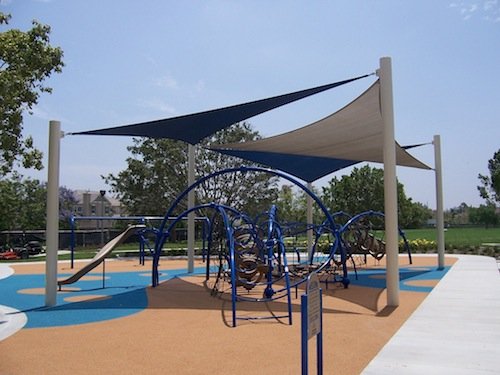Global Shade
0451 074 233
What to Consider When Installing Shade Sails and Structures
July 4th, 2015 · Published to Shade Sails by nicole
If you are reading this article, it’s not a long-shot to presume you are in pursuit of reliable outdoor protection from the harmful factors of sun rays (ultraviolet radiation). In countries with strong solar radiation, this really is an issue, so now here you are considering your options.
Constructing shade sails is one of the most effective ways of achieving your goal, but before you start doing so, you should first consider what the important factors are if you go with this choice. To help you out, I’ve sourced information from the STA’s 2013 Fabric Structures Committee Report which I recommend you read should you be looking to learn more on this topic.

Shade Sails and Structures are a popular shade solution, but careful consideration should be made when purchasing and installing them
Let’s look at what you need to consider when purchasing shade sails and structures so you can get a clearer picture.
- Weather protection utilisation – Though shade sails are mainly used for sun protection they can also be used for: shielding vehicles, preventing falling debris, pools (keeping them cool in summer while reducing the need for chemicals), machinery and outdoor work areas.
- Costs – The cost advantages of shade sails are many: low costs of material, shorter time for installation (less labor), lower replacements costs (they new fabric roof is way cheaper than any other roof solution) and energy savings.
- Fabrics – Given the point above, the fabrics used for shade sails provide protection from UVR, lowering the temperature; some are even flame resistant, waterproof and their life span is about 15 years. All of that with better price! The usual choice is HDPE-High Density Polyethylene, for waterproof choice it is PVC-Poly Vinyl Chloride fabric and a top of the line choice PTFE-Poly Tetra Fluoro Ethylene. (Click here to see the fabrics we use here at Global Shade(
- Fabric properties – Those are: design parameters, flexibility, heat transference of fabric, light and translucency and the long life of the fabric.
Now let’s see what you need if you want to go ahead with the installation of shade sails and structures:
- Safety – comes first! Each site is different so a Sample Safe Work Method Statement is required for risk assessment. There could be underground searches, working at heights or possible water flow risk, and everything must be done in order to prevent escalations of those risks.
- Design Options – To explain this we will go from simple to more complicated solutions. Shade sails need only fabric for cover. Shade structures need fabric supported by a frame. Custom structures are these shade structures but built for a specific site which is why we here at Global Shade specialise in, though we do have a range of affordable DIY shade sails
- Engineering – Shade structures are susceptible to wind and rain, reacting by their influence. So during design, it’s important to follow the rules as the state implies. Those rules consist of: codes and standards, site-specific requirements, needed local government documentation followed by the national legislation.
- Installer licensing and training – Each state varies in what it considers to be the basic skill and training necessities to install fabric structures, in this case, “The National Occupation Licensing Authority” is responsible for that in Australia. The benefits of national licensing are considerable.
Conclusion
There are many things to consider when looking at purchasing and installing shade sails and shade structures. You’re forgiven if it all sounds too complicated for you and that’s ok, that’s where Global Shade can help! Trust one of the pioneers in this business. Global Shade can take that problem off your hands.
With 25 years of experience combined with top quality service, you’d be remiss to lets this opportunity pass you by! Contact us today and get your shade sail purchased and installed hassle-free!
Related Topics
- Common Uses for Shade Structures
- Prevent skin cancer with top quality shade structures
- For High UV-Ray protection, consider Shade Sails
- 5 Ways Shade Sails can improve your home